-

人教版新目标初中英语八年级上册Can you come to my party教案3篇
Step 3 (3b)First, tell the students when we talk about our future plans, we often use: I’m+verb+ing When we talk about what we must do, we use have to. Ask the students to fill in the blanks in 3b. The answers are: shopping, go to see, a test, I’m going, my family. Step 4 (3c)Let the students write an e-mail message to a friend. Say why you can’t visit next. Before the exercise, ask the students to give some possible answers and write them on the blackboard. So the students will feel easy to finish the writing exercise. After they finish it, Let them to correct it in groups first. Each group chooses theirs best one to read in front of the whole class. Step 5 ( planning a party )First read the conversation in the box together. Then ask the students to turn to page 88.Write down everything you have to do next week. Write in all the things you have to do . Ask the students to look at the list. Ask them “What day are you free?” This is when you can have your party. Step 6 (Self check 1 )Let the students to fill in the blanks with the words given. Change the forms of the words if possible. Then make their own sentences. The answers are: visit, playing, have to, study, comeStep 7 (Self check 2)Imagine you are Marie. Read the information and look at your schedule. Write replies to the invitation.

人教版新目标初中英语八年级上册I’m going to be a basketball player教案3篇
教学目标1.知识目标:(1)学习What are you going to be when you grow up?/How are you going to do that?句式。(2)学会用英语描述有关职业的表达法。2.能力目标:(1)能够谈论为实现理想所做出的打算和安排。(2)能够谈论未来自己与他人理想的职业及原因。(3)能用英语描述课余时间的活动安排,最终具备表达综合信息的能力。3.情感目标:新学期到来之际,让他们在学习、体育、饮食、特长、读书等方面制定计划,教育学生合理安排自己的课外生活,思考自己的理想职业及适合自己的职业。教学重点、难点本单元的重点为“be going to”表将来,want to be, what,where, when,how引导的特殊疑问句。难点是语言目标的实现。教材分析本单元以I am going to be a basketball player为话题,共设计了三部分的内容:一、Section A该部分有4个模块。第一模块围绕Do you think these jobs are interesting?这一话题展开思维(1a)、听力(1b)、口语(1c)训练;

人教版新目标初中英语八年级下册Why don’t you get her a scarf教案
教师带领学生复习有关描述宠物的词汇,采用教师提问学生回答的方进行。如:T:What animals do you think would be good pets?What animals do you think would be bad pets?What do you think are good animals for a six-year-old child?然后学生进行 pairwork 练习。Task two: 师生互动,学习探究 1、播放3a部分的录音,引导学生一边听录音,一边跟读。2、通过听录音学生回答以下问题:Why do you think pot-bellied pigs are popular?What are the advantages and disadvantages of keeping such a pet?教师对学生的回答进行及时点评。3.学习范文,学习重点短语,为下步的模仿写作提供语言素材。T :1. )Have you ever kept a pig as a pet?Do you like pigs? St.:No.…Why don’t you like to keep a pig? St: No.They’re too dirty and lazy(Do you know in some foreign countries like Hollyland, Australia,pigs are the most popular pet.there’s a kind of pig.(图)it has an interesting name? it ‘s called a pot-bellied pig.) Now,let’s learn an article about this kind of interesting pet.2.)play the tapeSt.:Listen and repeat3.)show some Qs on computer(本子St.: read silently,then answerthe Qs(本子)4.)Ask ss. Close book and retell this passage.(what is a pot-bellied pig? Is it a good or bad pet? ) St.: retell it to each other“A pot –bellied pig is a popular pet now…”5.read the article together.St.:.practice reading

人教版新目标初中英语九年级上册I like music that I can dance to教案
教学目标: 1. Express preferences2. Talk about one’s likes and dislikes and the reasons3. Learn to express one’s opinions 4. Learn to write a reply 语言功能: 1) Talk about one’s preferences, using t he relative clause2) Talk about people’s likes and dislikes and the reasons3) Talk about opinions语言结构: Relative clauses with that and who语言目标:What kind of music do you like?I like music that I can sing along with.I love singers who write their own music.We prefer music that has great lyric.重点词汇及短语:heart, photography, interest, class, whatever, miss, okay, expect, sweet, taste, itself, laboratory, cancer, increase, biscuit, main, care, prefer… to…, remind somebody of …, dance to, sing along with, be sure to, interest somebody, make somebody adj., to be honest, suit somebody, on display, catch up教学重难点:What do other people think of the different kinds of things? How to express one’s opinions? 学习方式:讨论,合作学习情感目标:通过本单元的学习,能提高学生的艺术鉴赏能力和审美情趣,并引导学生养成健康的饮食习惯。课时安排5课时第一课时:Section A: 1a-2c第二课时:Section A : 3a-4第三课时:Section B:1-2c, Self check2第四课时:Section B: 3a-4, Self check1第五课时:Self check ReadingI like music that I can dance to.

人教版新目标初中英语九年级下册By the time I got outside, the bus had already left教案
Ⅰ. Teaching Aims and Demands1. Knowledge Objects(1) Key Vocabularyoversleep(2) Target LanguageWhat happened?I overslept. And by the time I got up, my brother had already gotten in the shower.2. Ability Objects(1) Teach the students to use the new words.(2) Train the students to narrate past events with the Past Perfect Tense.(3) Train the students' listening and speaking skills with the target language.3. Moral ObjectIt’s a good habit to go to bed early in the evening and get up early in the morning. So you’ll never be in a hurry in the morning.Ⅱ. Teaching Key Points1. Key Vocabularyoversleep2. Target LanguageNarrate past events with the Past Perfect TenseⅢ. Teaching Difficult Points1. Train the students to narrate past events with the Past Perfect Tense.2. Train the students to understand the target language in spoken conversation.Ⅳ. Teaching Methods1. Thinking of examples from the students' real lives.2. Making sentences by looking at the pictures.Ⅴ. Teaching AidA tape recorderⅥ. Teaching ProceduresStep I Revision1. Revise the language points in Unit 8.Ask some questions like this: What volunteer work would you like to do?Help the students to answer, I’d like to…/I love to…/I hope to2. Practice the dialogue in Activity 3c on page 62 again. Get students to role play the similar dialogues with the following.

人教版新目标初中英语九年级下册Rainy days make me sad教案
1. 教材分析本单元以how do things affect you?为话题, 从颜色、天气、音乐、广告、产品等方面谈论了外界事物如何影响人的心情。要求学生掌握表达某物或某事给人带来的感觉、看法或影响等。共设计了四个部分的内容:Section A 该部分有4个模块:第一模块围绕Which restaurant would you like to go to?这一话题展开思维(1a)、听力(1b)、口语(1c)训练;第二模块围绕How does music affect you? 进行听力(2a-2b)、口语训练(2c);第三模块继续围绕how do colors in the restaurant affect you这一话题展开训练,训练形式为阅读和问题体验(3a)和小组活动(3b);第四模块仍就How do things affect you这一话题以调查的形式展开讨论。Section B该部分有4个模块:第一模块围绕产品广告对人们的影响这一话题以“配对”(1a)与“列举”(1b)两种形式展开训练;第二模块继续围绕How do things affect you? 进行听力(2a-2b)、口语对话训练(2c);第三模块围绕“Advertising”这一话题展开阅读(3a-3b)和写作(3c)训练;第四模块围绕How posters affect you这一话题以口语训练形式展开小组活动。

人教版新目标初中英语七年级下册Where is your pen pal from教案
2.1Match the country with the language.Step II Reading3a? let the students read the letter fast and answer the questions.? Let the students ask more questions about the letter as possible as the can.Step III Writing3b.Step IV. Pairwork2cStep V Listening2a, 2bStep V. HomeworkExercises book(1) P3Exercises book (2) P3Period FourStep I . Dictate the words and sentences in Unit1.Step II. Self-checkStep III. Check the answers for Exercises book in the unit.Step IV. Home workRevise and preparation for unit 2.教学反思:通过本单元的学习,学生基本可以谈论人们的国籍,居住城市及其所说的语言,通过书信方式去介绍自己并寻找笔友。但在涉及到国外的一些城市时,学生对这方面的知识相对欠缺,能介绍的城市并不多,也反应出学生课前预习不充分,这跟学生学习条件也有关,大多数学生无法通过网络获取所需信息。因此,在以后的教学中要多指导学生通过计算机网络获取信息,拓宽知识面。

人教版新目标初中英语八年级上册Could you please clean your room教案3篇
一、 教学内容Section A 1a----1c二、 教学目标1.学习词汇do the dishes, make the bed, take out the trash, fold the clothes, do the laundry, sweep the floor, clean the living room.2.句型 Could you please clean your room? Yes, sure.三、 教学准备 学生预习本单元所有的词汇多媒体课件 活动表 奖品四、 教学过程Pre-task1. Warming upEnjoy ourselves. Watch cartoon Cinderella. 看动画片段《灰姑娘》导如入本课话题和新词汇“chores”美丽善良的鬼姑娘因继母的嫉妒,每天得做所有的家务。片段的主题使学生联想到本课的话题。2. learn new words and phrasesLook! What is she / he dong? 看图学习动词词组do chores, do the dishes, make the bed, take out the trash, fold the clothes, do the laundry, clean the living room.3. Guessing game.What is she doing ? 4. Pair work. 1a, Do you do these things at home? Write “Y” for “yes” and “N” for “no”.5. Listening . 1b , Peter’s chores or Mom’s chores?理解目标语Could you please clean your room? Yes, sure.Write “M” for Mom’s chores, “P” for Peter’s chores in the chart.6. PairworkLook at the picture,Ask your partner to do the chores that you see. 7. Interview Who is the most able at home? 1) What chores do you do at home? How often do you do the chores? Work in four, interview each of the students in the group, fill in the chart.

人教版新目标初中英语八年级下册Have you ever been to an amusement park教案
(1)Have you ever been to …? Yes, I have. / Yes, I have ever been to …No, I haven’t. / No, I have never been to …(2)When did you go there? I went there last year. (3)I have never been to a water park. Neither have I. I have ever been to an amusement park. So have I. (4)How long have you been studying English? I’ve been studying English since nine o’clock. I’ve been studying English since I came back home. I’ve been studying English for five hours. (5)What’s that? It’s an amusement park in Japan. I’ve never been to an amusement park like it before. It’s fun to learn another language. Let’s go tonight. Isn’t this great?space museum, amusement park, water park, South America, Peru, Holland, European culture, tour guide, flight attendant, musical instrument, more than, be from, get to, take lessons, neither, discover, graduate, change

人教版新目标初中英语八年级下册Would you mind turning down the music教案
Step 4. Group work (4)1. Ask a pair of students to read the dialogue. Say, This activity provides speaking, listening and writing practice using the target language.2. Ask students to complete the work in groups.3. Check the answers with the whole class. 4. Explain some of the language points. Step 5. Word review (Self check 1)1. Ask students to read the words and the phrases given. 2. Fill in the blanks with proper forms of these words to complete the sentences. 3. Check the answers with the whole class. Homework:Do activity 2 on page 57 after class. Period 6Teaching aims: 1. Teach vocabulary words and the useful expressions. 2. Enable the students to learn etiquette in different culture. 3. Help the students learn how to behave politely in public places and in daily life. Teaching procedures:Step 1. RevisionHelp students to review the function of making requests through a free talk. Then lead them to the topic of etiquette. Explain the meaning of etiquette. Or, ask students to look it up in the dictionary. Step 2. Pre-reading (Section 1)1. Ask students to read the picture and make a list with their partner about how many rules of etiquette can be seen being broken.

人教版新目标初中英语九年级上册It must belong to Carla教案
一、Section A该部分有4个模块。第一模块围绕Whose volleyball is this? 这一话题展开思维( 1a)、听力(1b)、口语( 1c)训练;第二模块围绕上一模块中的话题进行听力( 2a-2b)、口语训练( 2c);第三模块继续围绕前两个模块中的“making inferences”展开训练。训练形式为阅读排序( 3a)和两人问答(3b);第四模块仍就上一话题展开讨论。二、Section B该部分有4个模块。第一模块要求根据图画和所提供的单词写出合理的句子;第二模块在听力( 2a-2b)和分角色口语训练( 2c)的基础上,继续进行“推测”训练; 第三模块围绕“Strange events in Bell Tower neighborhood”这一话题展开阅读( 3a)和写作(3b -3c)训练;第四模块以dream为话题展开小组活动。三、Self Check该部分有3个模块。第一模块以填空形式对所学词汇进行训练;第二模块就8个谚语展开阅读和讨论。

人教版新目标初中英语九年级下册I’ll help clean up the city parks教案
Talk about offering help (P60)I’ll help clean up the city parks.A: I’d like to work ...B: You could help ...Talk about ways to tell people about the Clean-Up Day (P61)We need to ...We can’t ...I’ll ...Talk about the work the volunteers do (P62)These three students all volunteer their time to help other people.Somebody loves to ... / helps ... / plans to ... / wants to ...A: What do you like doing?B: I like ... A: What kind of volunteer work do you think I could do?B: You could ...1. 重点词汇advertisement, fix, repair, pleasure, blind, deaf, shut, carry, specially, fetch2. 认读词汇hunger, homeless, cheer, clean-up, sign, establish, major, commitment, elementary, veterinarian, coach, similar, call-in, strategy, disabled, organization, unable, support, appreciate, donation, part of speech, pronoun, adverb, preposition, conjunction, donate, Jimmy, Sally3. 词组clean up, cheer up, give out, put off, set up, think up, take after, fix up, give away, put up, hand out, work out, at once
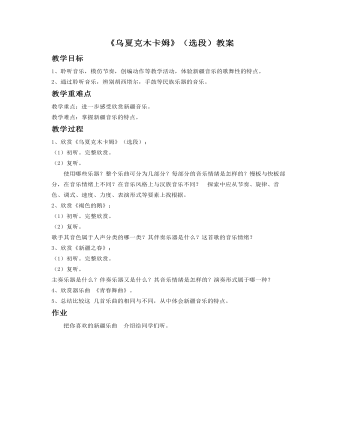
《乌夏克木卡姆》(选段)教案
1、欣赏《乌夏克木卡姆》(选段);(1)初听。完整欣赏。(2)复听。 使用哪些乐器?整个乐曲可分为几部分?每部分的音乐情绪是怎样的?慢板与快板部分,在音乐情绪上不同?在音乐风格上与汉族音乐不同? 探索中应从节奏、旋律、音色、调式、速度、力度、表演形式等要素上找根据。2、欣赏《褐色的鹅》;(1)初听。完整欣赏。(2)复听。歌手其音色属于人声分类的哪一类?其伴奏乐器是什么?这首歌的音乐情绪?3、欣赏《新疆之春》;(1)初听。完整欣赏。(2)复听。
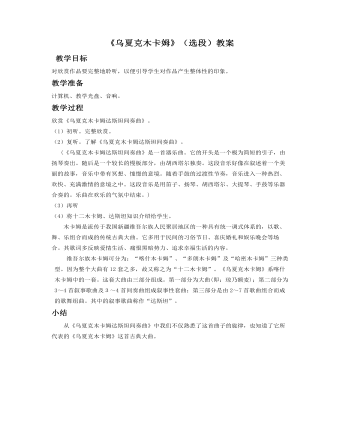
《乌夏克木卡姆》(选段)教案
木卡姆是流传于我国新疆维吾尔族人民聚居地区的一种具有统一调式体系的,以歌、舞、乐组合而成的传统古典大曲。它多用于民间的习俗节日、喜庆婚礼和娱乐晚会等场合。其歌词多反映爱情生活、痛恨黑暗势力、追求幸福生活的内容。 维吾尔族木卡姆可分为:“喀什木卡姆”、“多朗木卡姆”及“哈密木卡姆”三种类型。因为整个大曲有12套之多,故又称之为“十二木卡姆”。《乌夏克木卡姆》系喀什木卡姆中的一套。这套大曲由三部分组成。第一部分为大曲(即:琼乃额麦);第二部分为3~4首叙事歌曲及3~4首间奏曲组成叙事性套曲;第三部分是由2~7首歌曲组合而成的歌舞组曲。其中的叙事歌曲称作“达斯坦”。
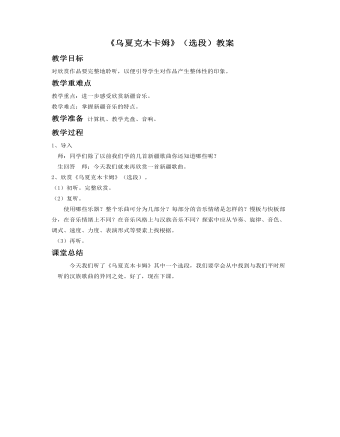
《乌夏克木卡姆》(选段)教案
教学重难点教学重点:进一步感受欣赏新疆音乐。教学难点:掌握新疆音乐的特点。教学准备 计算机、教学光盘、音响。教学过程1、导入 师:同学们除了以前我们学的几首新疆歌曲你还知道哪些呢? 生回答 师:今天我们就来再欣赏一首新疆歌曲。2、欣赏《乌夏克木卡姆》(选段)。(1)初听。完整欣赏。(2)复听。使用哪些乐器?整个乐曲可分为几部分?每部分的音乐情绪是怎样的?慢板与快板部分,在音乐情绪上不同?在音乐风格上与汉族音乐不同?探索中应从节奏、旋律、音色、调式、速度、力度、表演形式等要素上找根据。 (3)再听。 课堂总结 今天我们听了《乌夏克木卡姆》其中一个选段,我们要学会从中找到与我们平时所听的汉族歌曲的异同之处。好了,现在下课。
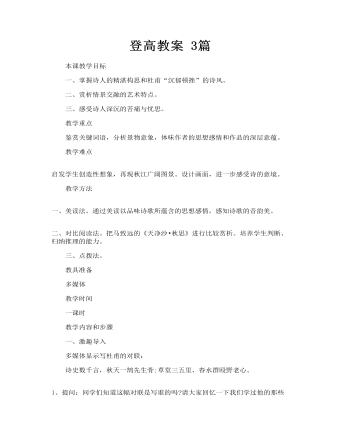
登高教案 3篇
一、激趣导入 多媒体显示写杜甫的对联: 诗史数千言,秋天一鹄先生骨;草堂三五里,春水群殴野老心。 1、提问:同学们知道这幅对联是写谁的吗?请大家回忆一下我们学过他的那些作品?能背诵一首我们共同欣赏吗?(学生背诵)今天我们来学习他的另一首诗歌《登高》(板书)

《青藏高原》教案
这是作曲家张千一创作的一首歌曲。以明朗高亢而富有藏族风格的旋律,热情地歌颂了美丽庄严的青藏高原,表达了对祖国锦绣山川的眷恋、热爱之情。全曲为羽调式;节拍以四四拍子为主,间插以四二、四三拍子,引子为散板;曲式结构为有引子、前奏的二段体。引子开始,由人声合唱出一个明朗、高亢、山歌风的衬腔,把人们带入到辽阔的青藏高原的意境之中。接着,由器乐演奏深化了这一音乐主题。A段由起承转合的四个乐句构成。第一乐句作为全曲音乐主题的集中体现,具有秀美、明亮、亲切的特征;第二乐句继续承接着这一特征,切分节奏的运用使之更具活力;第三乐句作为一个转折,主要在前半句的音区和旋律音调上发生了变化,较低的音区和较为低回委婉的旋律,使感情表达更显真挚;第四乐句开头出现的后半拍起唱的节奏,使之既富有变化,又富有动力,后半乐句的旋律与第二乐句的结尾相同,使之具有“合”部的特征。

《黄土高坡》教案
(一)学生随《乡下的阳光》进教室,师生问好。(二)聆听《黄土高坡》、《洞庭鱼米乡》。1、引入:我们生活在江南,你有没有在电影或电视中看到我国黄土高原?出示地图,找一找黄土高坡的位置。(在我国西北)2、在《黄土高坡》背景音乐下,展示CAL课件中的黄土高原的风土人情的图片:(1)漫漫黄土,低矮的窑洞。(2)沙尘漫漫飞舞。(3)人们在劳动。3、师:是啊,虽然黄土高原自然条件恶劣,但世代居住在这里的人们依然热爱他们的家乡,热爱他们的这一片土地,让我们听听他们的歌《黄土高坡》。设问:这首歌曲给你什么感受?4、刚才我们到了黄土高坡,现在我们一起去有“鱼米之乡”的洞庭湖吧。一起在地图上找一找洞庭湖的位置。(在我国中南)(课件播放洞庭湖区秀丽风景和人们张网捕鱼的图片。(同时播放《洞庭鱼米乡》背景音乐。)
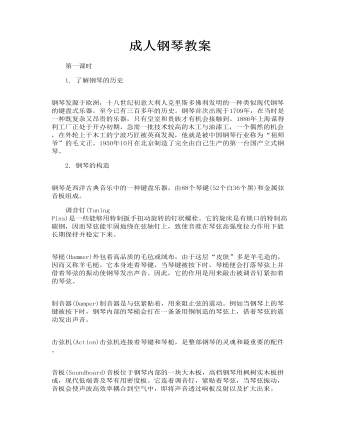
成人钢琴教案
2. 钢琴的构造 钢琴是西洋古典音乐中的一种键盘乐器,由88个琴键(52个白36个黑)和金属弦音板组成。 调音钉(Tuning Pins)是一些能够用特制扳手扭动旋转的钉状螺栓。它的旋床是有锁口的特制高碳钢,因而琴弦能牢固地绕在弦轴钉上,致使音准在琴弦高强度拉力作用下能长期保持并稳定下来。 琴槌(Hammer)外包着高品质的毛毡或绒布,由于这层“皮肤”多是羊毛造的,因而又称羊毛槌。它本身连着琴键,当琴键被按下时,琴槌便会打落琴弦上并借着琴弦的振动使钢琴发出声音。因此,它的作用是用来敲击被调音钉紧扣着的琴弦。
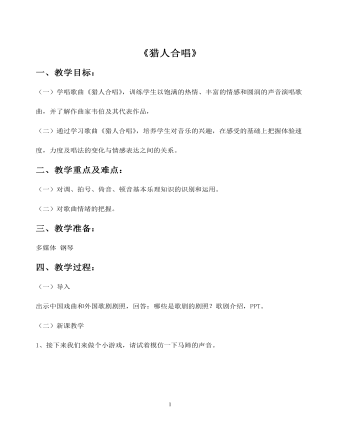
《猎人合唱》教案
一、教学目标:(一)学唱歌曲《猎人合唱》,训练学生以饱满的热情、丰富的情感和圆润的声音演唱歌曲,并了解作曲家韦伯及其代表作品,(二)通过学习歌曲《猎人合唱》,培养学生对音乐的兴趣,在感受的基础上把握体验速度,力度及唱法的变化与情感表达之间的关系。二、教学重点及难点:(一)对调、拍号、倚音、顿音基本乐理知识的识别和运用。(二)对歌曲情绪的把握。三、教学准备:多媒体 钢琴四、教学过程:(一)导入出示中国戏曲和外国歌剧剧照,回答:哪些是歌剧的剧照?歌剧介绍,PPT。(二)新课教学1、接下来我们来做个小游戏,请试着模仿一下马蹄的声音。2、把它们组合在一起,大家还能轻松地完成吗?3、把节奏变成旋律再来挑战一下吧。4、请同学们静静地听《猎人合唱》,思考:①分几个乐段?②带有一种什么样的感情?③是哪种曲子的风格?5、歌曲教唱。①学唱旋律,注意换气记号,弱起小节,前倚音。②有节奏地念歌词。③填词演唱。